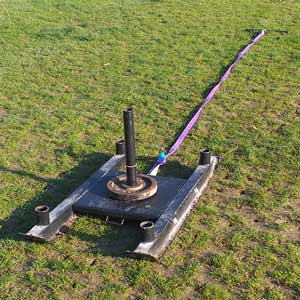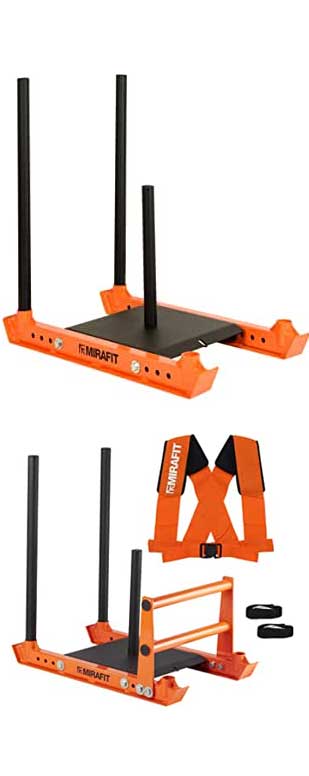 Sled pushing and pulling provide a massive benefit to working ratio for all types of training. There are several types of sled which include the Power Sled. The kind of sled you need will depend on several factors.
Sled pushing and pulling provide a massive benefit to working ratio for all types of training. There are several types of sled which include the Power Sled. The kind of sled you need will depend on several factors.
Over the years, personal experience has shown me that weekly sledding (2-3 times a week) makes the work in the weight room easier and my lifts go up (weight or rep increases) easier. I use the Powers sled for conditioning/GPP (general physical preparedness)
Whatever your goals, whether it’s to be bigger, stronger, leaner, faster or fitter, you need to have a good level of conditioning. Sledding is the most efficient way to achieve this conditioning and will work alongside all manner of programs, whether you are training for strength, hypertrophy, fat loss or any other sport for that matter.
Click Here For Power Sleds Prices & Availability
Sled work doesn’t have to be killer to improve your conditioning. Work should be challenging but doesn’t have to be brutal. A few pushes and pulls each week will help push your lifts up. After training with a sled for a while, you’ll notice a good return (in the weight room) on the work put in.
Sleds can be used as a strength-building tool as well by pushing heavier weights for shorter distances, great if you don’t have access to standard gym equipment.
Sleds can be used to train both the upper and lower body. In fact, it’s possible to base a whole program around the sled, a program that works every muscle.
Benefits Of Power Sled Work
- Increases overall conditioning/GPP Increases gains in the gym.
- A high benefit to work ratio
- Increases strength
- Good for hypertrophy
- Can work the upper and lower body
- Can work any muscle
- Many exercises/variations possible
- Very versatile, can be used for many exercises.
- All positive movements (concentric contraction)
- No negative movements (eccentric contraction) allowing for quick recovery
- Will work alongside most programs and sports
Power Sled Negatives
- Some initial investment’s required.
- Accessories and plates may have to be purchased also.
- Space is needed to push.
- For most a car’s required to transport to open space
- Heavy, good for training bit of a pain for transport
The Most Important Consideration When Buying A Power Sled
As you can see the benefits far outweigh the negatives, which are hardly ‘negatives’ really, more like inconveniences. Before rushing out and buying a sled, you must consider this vital point.
What Surface Are You Pushing & Pulling On?
Some will be sledding on the grass and some on concrete. You may be sledding in a park, your lawn, a car park or out in the road. Are you sledding on grass or concrete?
The Power Sled has two ski’s that run the length of the sled. Other types include the standard sled which is flat and only used for pulling or the Prowler which has three small feet.
Power Sleds are ideal for grass as they always slide across and will never dig in no matter how soft the ground is. Power Sleds will make an awful noise on concrete and will easily get caught up in stones and debris laying on the concrete.
Prowlers are ideal for concrete and indoor flooring as they touch the floor over a low surface area, they are not at al good for grass as the front foot is notorious for digging in if your training on grass buy a Power Sled If you’re training on concrete buy a Prowler.
Power Sled Vs Prowler
Both Power Sleds and Prowlers are excellent conditioning tools that can be pushed or pulled.
The Power Sled is rectangular shaped featuring two skis and a solid base in the middle. The base features a 2inch loading pin for Olympic plates and a loop or a hole each side for a rope attachment. Each end of the two ski’s features holes which accommodate verticle bars which are used to push the sled. Low bar attachments are available which offers low horizontal bars which makes pushing the sled far more challenging.
The Prowler is a triangle shape featuring three small ski’s at each corner. 2 removable verticle bars are at the back for pushing and loading weights. The front features two built-in horizontal low bars and loops for attaching a rope.
Power Sled
- Rectangular shape
- 2 Full-length skis
- 2 Verticle bars
- Pulling loops
- Loading pin
- Low bar attachment available Ideal for using on grass
Prowler
- Triangular shape
- 3 small skis
- 2 verticle bars/loading pins
- Pulling loops
- Built-in low bar Ideal for using on concrete
Power Sled & Prowler Harnesses & Slings
Pushing is built-in with the Power Sled, grab the bars and push for pulling you’re going to need a Power Sled Harness and a Heavy Duty Sling.
Both must be up to the job of pulling a loaded sled. Put the harness on with the sling attached, attach the sling to the sled and start walking.
Weight lifting belts also work very well for pulling the sled. Attach your heavy-duty sling to your belt, put on the belt, attach the sling to the sled and away you go. Some upper body sled exercises will require two heavy-duty slings.
Power Sled Accessories
The harness and sling are the main accessories required for the Sled or Prowler you will also need some decent Heavy-Duty Carabiner Clips and some Olympic Plates. If you engage in any backward pulling, and you should as it really burns up the calves and quads A Handle that can be clipped onto the sling is ideal.
All you need now is a decent pair of shoes and a water bottle. After rain and in the wintertime grass can be slippery, bear this in mind and use grippy shoes in these situations. When pulling in park areas with dog walkers don’t leave your water bottle on the ground. Inquisitive dogs will lick (or worse urinate on) your bottle. Attach an elastic band around one of the bars, use the band to keep the water bottle on the sled. You won’t have any trouble with dogs that way.